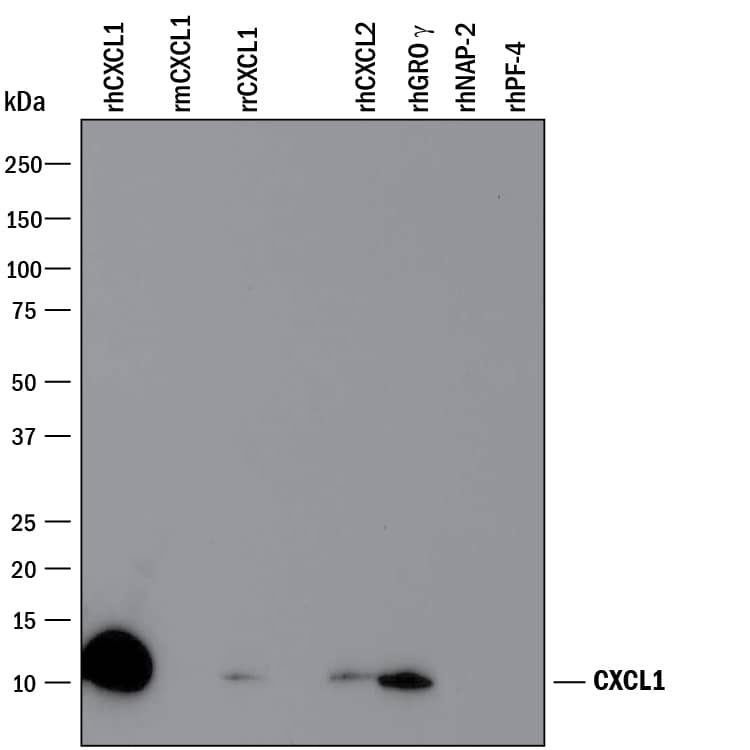Human CXCL1/GRO alpha/KC/CINC-1 Antibody
R&D Systems, part of Bio-Techne | Catalog # AF275


Key Product Details
Species Reactivity
Validated:
Cited:
Applications
Validated:
Cited:
Label
Antibody Source
Product Specifications
Immunogen
Ala35-Asn107
Accession # P09341
Specificity
Clonality
Host
Isotype
Endotoxin Level
Scientific Data Images for Human CXCL1/GRO alpha/KC/CINC-1 Antibody
Detection of Recombinant Human CXCL1/GRO alpha/KC/CINC‑1 by Western Blot.
Western blot shows 25 ng of Recombinant Human CXCL1/GROa/KC/CINC-1 (Catalog # 275-GR), Recombinant Mouse CXCL1/GROa/KC/CINC-1 aa 20-96 (Catalog # 453-KC), Recombinant Rat CXCL1/GROa/KC/CINC-1 (Catalog # 515-CN), Recombinant Human CXCL2/GRO beta/MIP-2/CINC-3 aa 35-107 (Catalog # 276-GB), Recombinant Human CXCL3/GRO gamma/CINC-2/DCIP-1 (Catalog # 277-GG), Recombinant Human CXCL7/NAP-2 (Catalog # 393-NP), and Recombinant Human CXCL4/PF4 (Catalog # 795-P4). PVDF Membrane was probed with 0.1 µg/mL of Goat Anti-Human CXCL1/GROa/KC/CINC-1 Antigen Affinity-purified Polyclonal Antibody (Catalog # AF275) followed by HRP-conjugated Anti-Goat IgG Secondary Antibody (Catalog # HAF109). A specific band was detected for CXCL1/GROa/KC/CINC-1 at approximately 11 kDa (as indicated). This experiment was conducted under reducing conditions and using Immunoblot Buffer Group 3.Chemotaxis Induced by CXCL1/GRO alpha and Neutralization by Human CXCL1/GRO alpha Antibody.
Recombinant Human CXCL1/GROa (Catalog # 275-GR) chemoattracts the BaF3 mouse pro-B cell line transfected with human CXCR2 in a dose-dependent manner (orange line). The amount of cells that migrated through to the lower chemotaxis chamber was measured by Resazurin (Catalog # AR002). Chemotaxis elicited by Recombinant Human CXCL1/GROa (0.01 µg/mL) is neutralized (green line) by increasing concentrations of Human CXCL1/GROa Antigen Affinity-purified Polyclonal Antibody (Catalog # AF275). The ND50 is typically 0.03-0.15 µg/mL.Applications for Human CXCL1/GRO alpha/KC/CINC-1 Antibody
Western Blot
Sample: Recombinant Human CXCL1/GRO alpha/KC/CINC-1 (Catalog # 275-GR)
Neutralization
Reviewed Applications
Read 5 reviews rated 4.6 using AF275 in the following applications:
Formulation, Preparation, and Storage
Purification
Reconstitution
Formulation
Shipping
Stability & Storage
- 12 months from date of receipt, -20 to -70 °C as supplied.
- 1 month, 2 to 8 °C under sterile conditions after reconstitution.
- 6 months, -20 to -70 °C under sterile conditions after reconstitution.
Background: CXCL1/GRO alpha/KC/CINC-1
The gene for CXCL1/GRO alpha was initially discovered in hamster cells, using subtractive hybridization techniques, as a message that is over-expressed in tumorigenic cells and in normal cells during growth stimulation. The hamster cDNA was cloned and used as a probe for the subsequent cloning of the human GRO cDNA. Independently, a cDNA encoding a secreted protein with melanoma growth stimulating activity (MGSA) was also cloned from a human melanoma cell line and found to be identical to GRO. In addition to the initially cloned GRO gene, now designated CXCL1, two additional GRO genes, GRO beta or MIP-2 alpha and GRO gamma or MIP‑2 beta, which shared 90% and 86% amino acid sequence homology, respectively, with CXCL1, have been identified. All three human GROs are members of the alpha (C-X-C) subfamily of chemokines. The three GRO cDNAs encode 107 amino acid precursor proteins from which the N-terminal 34 amino acid residues are cleaved to generate the mature GROs. There are no potential N-linked glycosylation sites in the amino acid sequences. GRO expression is inducible by serum or PDGF and/or by a variety of inflammatory mediators, such as IL-1 and TNF, in monocytes, fibroblasts, melanocytes, and epithelial cells. In certain tumor cell lines, GRO is expressed constitutively. Similar to other alpha chemokines, the three GRO proteins are potent neutrophil attractants and activators. In addition, these chemokines are also active toward basophils. All three GROs can bind with high affinity to the IL-8 receptor type B. The rat homolog of human CXCL1, CINC, is much more active than human CXCL1 on rat neutrophils, suggesting that this cytokine may have selective species specificity.
Alternate Names
Gene Symbol
UniProt
Additional CXCL1/GRO alpha/KC/CINC-1 Products
Product Documents for Human CXCL1/GRO alpha/KC/CINC-1 Antibody
Product Specific Notices for Human CXCL1/GRO alpha/KC/CINC-1 Antibody
For research use only
